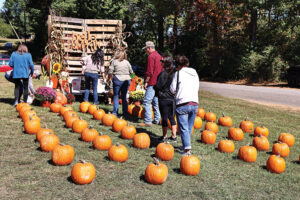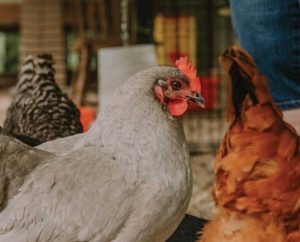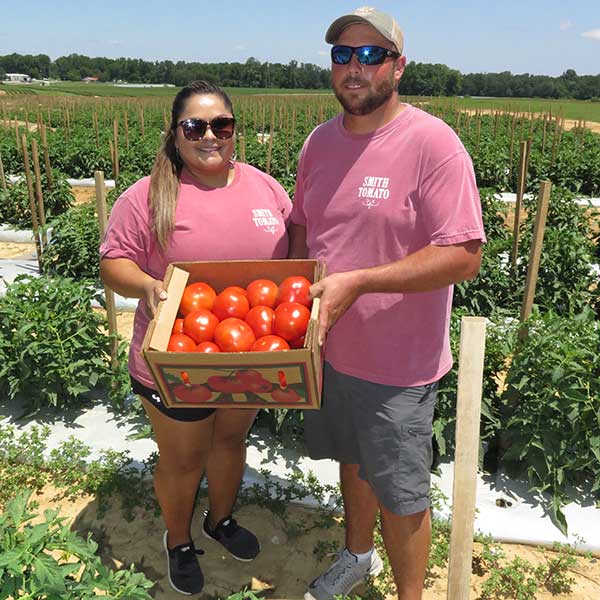
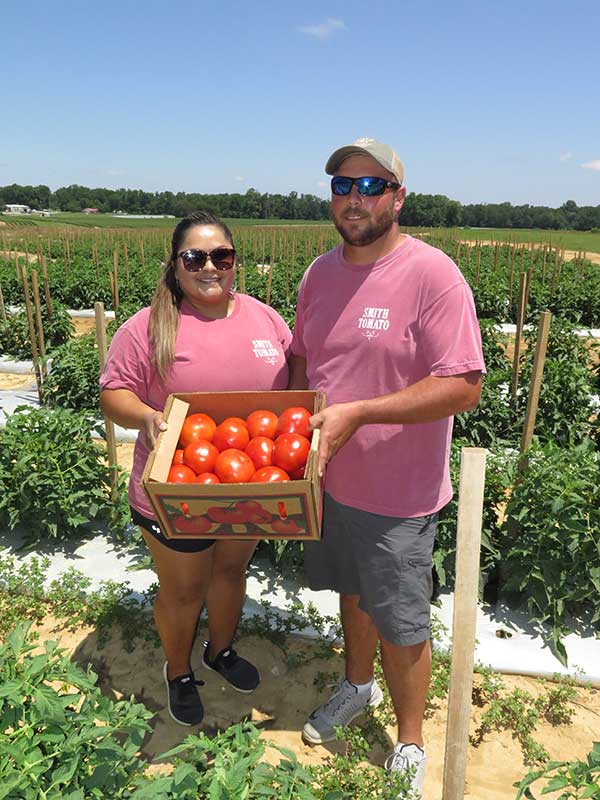
Chandler Mountain comes alive
in a sea of red at Smith Farm
Story by Elaine Hobson Miller
Photos by Graham Hadley
It’s tomato-picking time again on Chandler Mountain, the unofficial Tomato Capital of Alabama, where 800 acres of St. Clair County soil are devoted to this popular food every year. For several weeks now farmers have been pulling them from the plants, packing them up and selling them to distributors and the public alike.
Picking got off to a late start this year at Smith Tomato, a fixture on Chandler Mountain for more than 35 years. Cloudy days and excessive rain pushed back the picking, which usually begins the first of July, by a week. Coronavirus pandemic permitting, it will end with a big fall festival sometime in October.
“We’re only picking 1,500 to 2,000 boxes a day now, where we’re normally doing 4,000-6,000,” Smith Tomato co-owner Kista Smith-Lowe said in mid-July. “We pick every other day because it’s more productive. We get twice as many in less time because they don’t all ripen at once.”
Picking began on July 10, and they sold out of their Number One grade the first day. “The Number Ones have no imperfections, while our Number Twos have some flaws, but they taste the same,” Kista (pronounced Keesta) said. Distributors picked up 1,500 boxes, each weighing 25 pounds, that first day, but that’s far less than a normal day’s pickings.
The Smiths grow more than 100 of the 800 acres of tomatoes planted on Chandler Mountain each year. The exact amount varies because all fields aren’t the same size, and they rotate the fields. “We have about 200 acres all together,” Kista said. “We sell directly to the public and to distributors or middlemen, who then sell to grocery stores, etc., in Florida, Texas, Mississippi, even as far away as New York and Pennsylvania.”
Kista’s parents, Leroy and Kathy Smith, purchased the Smith farm 35 years ago from her uncle, who started growing tomatoes in the 1960s. The Smith kids have added to it and now have about 200 acres, plus some leased land. “We lost both of our parents in 2018,” Kista said. She and her two brothers run the place. Kista is in charge of bookkeeping and public sales, Phillip handles irrigation and fertilization and Chad handles spraying for pests. A crew leader answers to Chad. The Smiths were raised working with their parents in the fields, and Kista’s two daughters, ages 19 and 14, are already helping in sales, restocking and in the vegetable garden.
Their parents probably grew about half what the Smiths do now because it’s easier to grow tomatoes today than it used to be. “They had to do lots more field work by hand,” Kista said. “Daddy put quality before quantity, and that’s the way we were raised. I’m super proud of what he accomplished.”
Even though harvest time lasts only three or four months, tomato farming is a year-round affair, with only a couple of months off in late fall and early winter. The process begins in February when they work on the equipment. During March and April, they break ground. In April, they start planting, and from March to October, they’re staking, tying, setting fall plants out and picking. After each setting, all the tomato plants are staked and tied at least four times.
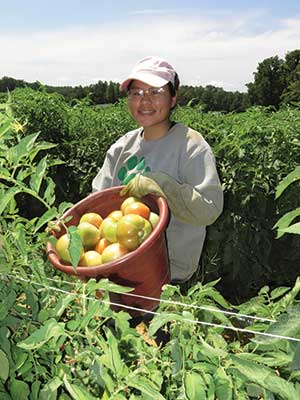
When October rolls around, the guys clean all the tractors and winterize the equipment. Their only down time is November through January, but even then, they might be placing orders. And that’s not counting the time they’re planting cover crops like hemp, wheat, turnips and other greens for winter, to put nutrients back into the soil. “Early in the year, we spend eight to 10 hours a day working this farm,” Kista says. “Four months of year, we have 14- to 16-hour days.”
The field process starts with plowing, using a machine that digs deep into the soil and brings it up in clods. Next comes fertilizing, using spreaders pulled by tractors. Then a chisel plow with gripper feet rips the ground and loosens it, and a tiller with rotating tines turns those clods into fine dirt. A plastic machine (that’s what they call it) pushes dirt into piles to form rows, puts down drip lines (plastic tubing, part of the irrigation system), fumigates, then covers the rows with plastic sheeting. “Our dad was the first farmer on Chandler Mountain to use a plastic machine,” Kista said. The fumigation chemicals go away in two weeks, before they put down the plants. A plant setter pokes holes in the plastic and drops water into those holes.
“Our migrant workers put the plants in by hand,” Kista said. “It’s much faster than machines can do it.”
The cost to grow tomatoes is about $10,000 per acre, and that’s before picking. It costs another $3.50 per box to pick, sort and grade them, so that’s about $7,000 in boxes and packing per acre. “We strive for 2,000 boxes of tomatoes per acre per season,” Chad said. “We have had as many as 3,000, but 2,000 is our feel-good mark.”
They wait until after April 15 to start planting to be sure they’ve seen the last frost. “We’ve had to pull up thousands of plants and re-plant due to a late frost,” Kista said. “Some companies put Styrofoam cups over them to protect them from unexpected frost, but that’s costly.” Even if the tomatoes live through the cold, it stunts them, and they won’t yield as much. “They’ll be fewer and smaller and more prone to disease,” Chad said.
Theyput about 400,000 plants into the ground each year, buying the seeds and having a plant grower raise them until they are about four weeks old. “We plant, stake, string and pick by hand, with a crew of about 50 people,” Kista said. “The tomatoes areprocessed in the field, meaning they are sized, graded and boxed there.”
“There’s so much technology now, andsome larger processors have machines that can detect size and grade the tomatoes,” Chad said. “Here, we used to have machines that graded them. We would put them on belts that had different sized holes in them. We went to grading in the field because it’s better production.”
Workers were picking about a third of their normal crop in mid-July, but sunshine and an upcoming full moon were sure to help. “A full moon when tomatoes are ripening is like 24 hours of sunlight,” said Chad. “It speeds up the process.”
“It’s very tiring but very exciting work,” said Kista. “Harvest is the most exciting time, especially when we pick more than ever for one day. Sore hands and backs, from picking, lifting, repairing tractors, planting are occupational hazards for us and the crew, too.”
Theyfight worms and insects that can kill the plants, like aphids and white flies, using insecticides and fungicides that are EPA-regulated. About a third of their chemicals are organic. Chad figures fertilizers and other chemicals and the plastic sheeting and tubing probably cost $400,000 per year. “Our profits may be four or five cents a pound after costs,” he said. “That would make us a good living.”
Your turn to pick
In August, when a field has only a couple of thousand tomatoes left, the Smiths turn it into a U-Pick farm, allowing the public to pick their own tomatoes at a cheaper cost than buying them by the box or basket. “It’s not productive enough for the migrants to pick at that stage, because they generally pick 5,000-6,000 tomatoes per day,” Kista said. “Their record is 8,000.”
They usually end the season with a big fall festival the first or second weekend of October, depending upon the Bama football schedule. “We grow pumpkins and sell those and cornstalks and other outdoor decorations like acorn squash and mums,” Kista said. “We have face painting and vendors who sell food and arts and crafts. Last year, we had close to 1,000 people show up. It’s hard to count because we don’t sell tickets. It’s free.” She said they aren’t sure whether they’re having the festival or not this year, due to the coronavirus pandemic, but urged readers to check their Facebook page for updates.
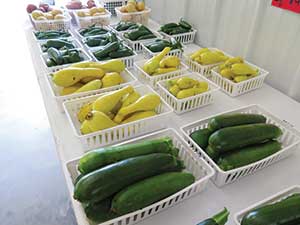
Tomatoes aren’t the only vegetables (or fruit, depending on the definition you prefer) that the Smiths sell. They grow melons, cucumbers, green beans, yellow squash, zucchini and grape tomatoes, and they buy potatoes and onions, jams and jellies out ofthe Birmingham Farmer’s Market, to sell to the general public out of their warehouse. That warehouse is open to the public from 8 a.m. to 5 p.m., seven days a week, during tomato season. They’re on Loop Road, just off Gallant Road, in Steele. (That’s 4575 Loop Road, Steele, for your GPS.)
They get anywhere from 25 to 100 customers a day, who buy for home canning and cooking. Customers can also pick up a T-shirt or baseball cap emblazoned with the Smith Tomato logo. It’s worth a trip to their warehouse just to see all the signs and symbols hanging on the walls and from the ceilings, like Farmall tractor advertisements, old license plates and kiddie pedal tractors, including one Chad drove as a youngster.
Looking ahead, the Smiths are contemplating opening a diner in two or three years. It will feature fresh, home-cooked vegetables and some sandwiches and lots of tomato dishes. Then folks can make a day trip out of shopping for fresh vegetables and eating them, too.
Now that’s something to look forward to!
Follow Smith Tomato on Facebook and online at smithtomatollc.com.
















